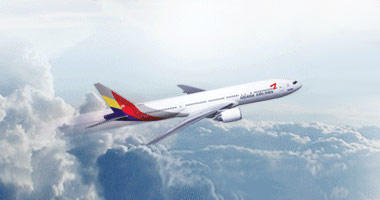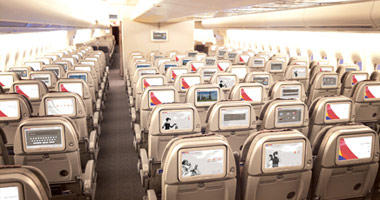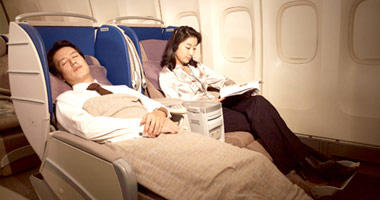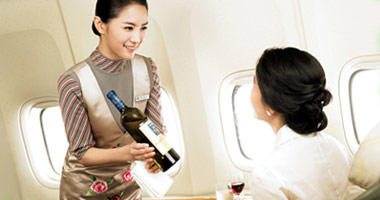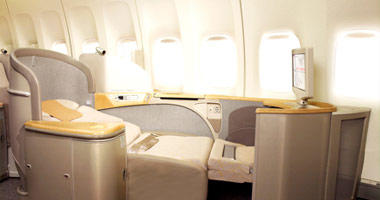Economy
Asiana’s economy class cabin is decorated in light coloured earth tones and is designed for maximum comfort. Modern slim line seats are arranged for ample leg room, even for those who are taller. The average seat pitch (the space between seats) is between 33 and 34 inches which is above the industry average. Seats also provide four-way adjustable head rests and come equipped with 110V power points for charging of personal electronic devices.
Passengers are treated to a complimentary hot meal and beverage service and are provided with an amenity kit which includes eye patches, ear plugs and stationary as well as slippers on routes to Europe and the Americas. International flights feature an in-flight duty free shop. For additional comfort, pillows and blankets are available for each passenger.
Entertainment is provided by individual seat back video screens with a wide selection of on-demand entertainment.

Business Class
Business Class features include wide seats with a privacy shell along the back. Seats recline to a near flat position, extending out to a 160 degree angle. The business class seat with leg and foot rests can be contoured for maximum comfort and is controlled electronically. Each seat is also equipped with a 110V power point and USB port.
In-flight service includes a choice of meal from the menu. A variety of western and Asian choices are offered along with top wines from France, Germany and the United States. On flights operated by the Airbus A330-300, Italian style espresso coffee is offered. An amenity kit is provided and in-flight duty free is also available.
Business Class Smartium
Available on flights between Seoul Incheon and New York, San Francisco, Los Angeles, London and Osaka, Business Class Smartium is a further step up from standard business class and features even greater levels of comfort, space and personal privacy. Seats are arranged in a staggered layout and are set within a hard back shell. The seat reclines within its privacy shell to a 180 degree lie-flat bed. Additional conveniences include storage spaces for shoes and other personal items as well as personal power supply for laptops and other electronic devices and side table for snacks and drinks.
In addition to the luxuries of standard business class, guests are offered an extensive in-flight menu where meals are individually plated and served upon request. An amenity kit with luxury beauty products is also offered. In-flight entertainment is available on larger video screens where a wide selection of on-demand entertainment is provided.

First Class and First Suite Class
The ultimate in service and privacy, First Class and First Suite Class feature lie-flat beds within their own partitioned space. First Class provides a privacy screen between each seat while First Suite Class seats are completely enclosed behind five foot high walls. Sliding doors can be closed for complete privacy. Guests in First Class Suite are completely ensconced within their own private cabin.
Guests in these premium cabins may pre-order their desired meal up to 48 hours in advance and are provided with full bedding in-flight as well as premium beauty products, slippers, letter sets and lounge wear. In-flight entertainment consists of hundreds of hours of on-demand entertainment.
First Class and First Suite Class cabins are available primarily between Seoul and Chicago, Los Angeles, New York, Frankfurt and Tokyo.

Carry-on Baggage
Economy class passengers are permitted one carry-on item. First and Business guests are allowed 2 pieces. The maximum weight for each piece is 10kg while the maximum linear dimensions are 115cm (L+W+H). One additional item such as small personal items, a diaper bag, stroller, laptop or small quantity of duty free may also be brought on as cabin luggage.
Checked Baggage
The free baggage allowance depends on the routing, frequent flyer status and class of travel. For travel to the Americas, including Canada, USA, Mexico and the Caribbean, the maximum dimensions for any bag regardless of class of travel or status level is 158cm (L+W+H). For non-Americas routes, baggage limits are based on weight. Refer to the handy charts below for guidelines on checked luggage. For specific baggage allowances for your fare type and status level, contact your Flight Centre consultant.


Sporting Equipment
Each type of sports equipment must meet Asiana guidelines for transport. This includes proper packaging and/or wrapping for damage prevention. In many cases, sports equipment is permitted as part of a passenger’s free baggage allowance but only if the item is within weight and size limits. Check with your Flight Centre consultant for specific details regarding the transport of golf clubs, bicycles, ski equipment, surfing or scuba equipment.

Musical Equipment
For those instruments that are not part of checked baggage, the item may, if space permits, be allowed in the cabin when an extra seat is purchased. To purchase a seat, the item must be larger than 115cm in total. Typical instruments permitted to be stowed in a seat include cellos, guitars and gayageums. A seat for a fare paying passenger must be purchased in conjunction with the extra seat.
Instruments that are checked in must be packed in a hard case. If the item is within weight and size limits it may be included as part of the passenger’s free baggage allowance.
Restricted or Dangerous Goods
Certain items are banned from carry-on and checked baggage. Carry-on restrictions include any liquid or gel container that is greater than 100mL. Weapons such as firearms, knives or other potentially dangerous goods are never allowed in the cabin.
Checked baggage guidelines restrict the carriage of flammable materials, liquids and gasses, explosives, fireworks, certain types of batteries, toxins and other types of hazardous materials. Items in question must be declared at time of check-in.
![]() If in doubt, leave it out. Even if you accidentally take a dangerous good on board an aircraft you can be fined and penalised.
If in doubt, leave it out. Even if you accidentally take a dangerous good on board an aircraft you can be fined and penalised.
Asiana Check-in
Check-in is always available at the Asiana ticket counter. Check-in for most international flights close 60 minutes before scheduled departure. Closing time for domestic Korean flights on Asiana is 20 minutes. Asiana asks that passengers check in for their flight a minimum of two hours ahead of scheduled departure. Any guest attempting to check-in after the closing time will not be allowed on board the flight.
Self-service kiosks are also available for check-in at most Korean airports as well as the international destinations of Tokyo Narita, London Heathrow and Frankfurt. Passengers must be travelling on an E-ticket to use these devices.
Web and Mobile Check-in
Anyone with an internet connection can check in for their flight, either on their personal computer or mobile device. Available services include domestic and international check-in, seat selection, duty free shopping and viewing of schedule and booking details. Those passengers who have a code-share flight as part of their booking may not be able to use web or mobile check-in.

Lounges
Asiana operates a number of lounges in key airports, including their hub facility at Seoul’s Incheon Airport. These inviting spaces offer a relaxing retreat, away from the hustle and bustle of the terminals and gate areas. Comfortable lounge chairs, complimentary snacks and beverages, Wi-Fi and a business centre are all features that are found in the Asiana Lounge.
The First Class lounge is open to all first class guests flying with Asiana or Star Alliance member airline. Platinum and Diamond Plus members are also provided with complimentary access to the lounge along with one accompanying passenger.
The Business Class lounge is available to those passengers flying with Asiana or a Star Alliance member in Business Class. Asiana Club Diamond members may also use the facility along with an accompanying passenger.
Asiana Club members may also gain entry to some lounges using their accrued mileage points.

Asiana Club
Asiana Club is the frequent flyer program for Asiana. Becoming a member of the program allows you to earn and redeem miles whenever you fly with Asiana or any of its partner airlines. The program also partners with several hotel brands, car rental companies and retailers.
Asiana Club is made up of five status levels or tiers, each offering an increased set of benefits based on miles accrued. The five program levels are Silver, Gold, Diamond, Diamond Plus, and Platinum. Below are just a few of the benefits one can expect.
Silver – Asiana Club’s base level allows passengers to earn and redeem points in the program. Silver members receive regular updates on Asiana news and events and program benefits. Miles flown are valid for 10 years from date of flown activity.
Gold – Members move to Gold status with the accumulation of 20,000 miles or 30 Asiana flights within a 24 month period. Benefits include priority for waiting reservations, dedicated check-in counter, priority baggage and additional free baggage allowance. Bonus miles of 5 percent are also accrued.
Diamond – Diamond status is reached at 40,000 miles or 50 Asiana flights within a 24 month period. In addition to Gold, benefits include 10 percent bonus miles and 12 year mileage validity.
Diamond Plus – Achieved with 100,000 miles or 100 Asiana flights within a 24 month period, Diamond Plus members receive complimentary lounge access and a 15 percent miles bonus.
Platinum – Achieved with the accumulation of 1,000,000 miles or at 1,000 flights from the point of subscription, Platinum members are able to use miles for family award travel and have use of an even greater selection of worldwide lounges. Platinum members receive a 20 percent miles bonus.

Asiana Fleet
Asiana operates a fleet of close to 90 aircraft. The aircraft type most commonly used between Seoul and Australia are the Boeing 777-200ER and Airbus A330-300. Asiana also operates the Airbus A380 on major routes such as Los Angeles, New York, Tokyo and Osaka.
The airline’s domestic and regional fleet includes the Boeing 767-300, Airbus A320 and stretched A321.
Asiana A380

Asiana Boeing 777

Asiana A330

Boeing 767-300

Asiana A320



